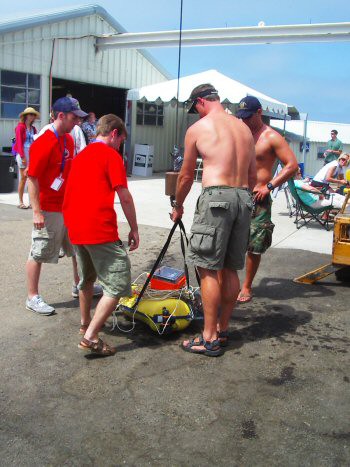IAUVC Conclusion

As promised, I'm here to provide closure to NCSU's journey to San Diego. And, no, we didn't place in the competition. We were so very close - one of the top contenders actually. We were able to demonstrate in practice all of the tasks, which, as far as I know, no other teams were able to do.
So let me just give you blow by blow starting Saturday morning:
First Preliminary Run
Our
robot has a network cable teather which allows us to recompile code and
run it on-the-fly. We consulted with David Novak, the in-charge-man for
the competition rules, and he assured us we could run with the teather
as long as we stepped away from the computer once we started our run.
However, when we arrived at the platform, the chief judge told us "nothin' doin'" and made us remove the cable and put in a blank puck (aluminum endcap where the cable origianlly entered the electronics tube).
This was a high stress situation and everyone stood up to it bravely, but unfortunately, the robot failed to run.
A
heated altercation then followed. We tried, as courteously as possible,
to get some sort of concession since we had been misinformed.
Eventually they agreed to let us run again that evening at 6:00.
Much stress ensued ...
Second (1.1?) Preliminary Run
At
least we had another chance on Saturday. We buttoned up the robot.
Brought it to the launch platform, lowered it into the water, and
nothing happened. OpenCV kept crashing, so our visual starting device (an orange "key") wouldn't work.
In
a mad, heart-stopping, dash, Matt opened up the robot and reconnected
the network cable for Sterling to put in a delayed start mechanism. In
a flash, the robot was back together and in the water.
We bagan to count the seconds ... slowly, slowly, our 5 minute timer ticked down and we waited for the robot to start.
Nothing happened.
Heat-broken, we pulled the robot out once again, and prepared for a very long night.
Final Preliminary Run
We had stayed up all night working on the robot. Trouble shooting bugs and trying to install a wireless network card so we could wireless start Seawolf.
Finally, the 11th hour dawned and to our horror, we found out our thrusters wouldn't work. Nothing. Zip. Matt rushed back to the hotel to get the spares. The spares didn't help. Some thrusters would cut on. We'd power cycle and a different thruster would cut on. It was a nightmare. No rhyme. No reason. Utter confusion.
Eventually, we found a combination that
worked. It was very touchy, but it worked. We tried it 4 times at our
booth. Twice at the starting platform. And finally, once on the dock.
However, when we lowered the robot into the water. It once again refused to work. Seawolf got stage fright.
To add to our misery, at this same time our batteries failed. So, we hauled Seawolf out of the water and did a NASCAR breakdown and battery replacement of the robot. There were cameras and people all around us taking pictures in amazement. It was pretty spectacular. The whole process took about 3 minutes.
With just a few minutes to spare we
once again tried to coax Seawolf into playing, but he refused, and
simply cut on two thrusters
and
spiraled
down
into
the
depths ...
Conclusion
It was all worth it. Sure, we're horribly disappointed, but it was
an amazing experience. Everyone loved the robot - the media (on live
San Diego TV), visitors ("I saw your robot on TV!"), and the divers
("f***-it, I like Seawolf better!").
Great job University of Florida you had an awesome robot and deserved the title. But, enjoy it while it lasts, cause next year
NCSU will be king!
Thanks for helping to keep our community civil!
This post is an advertisement, or vandalism. It is not useful or relevant to the current topic.
You flagged this as spam. Undo flag.Flag Post


